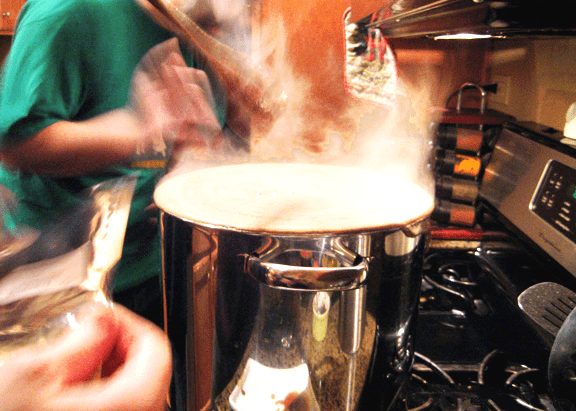 Let’s face it: anyone can mess up a batch of beer. That said, people have been brewing beer for thousands of years and have learned a thing or two about how to do it. As a beginning home brewer, you have a wealth of information at your disposal to help you avoid falling into the common pitfalls. To help you avoid them, here are 5 of the most common beginner home brewing mistakes made by beginners:
Let’s face it: anyone can mess up a batch of beer. That said, people have been brewing beer for thousands of years and have learned a thing or two about how to do it. As a beginning home brewer, you have a wealth of information at your disposal to help you avoid falling into the common pitfalls. To help you avoid them, here are 5 of the most common beginner home brewing mistakes made by beginners:
- Lax cleaning and sanitation – Most homebrewers have heard that cleaning and sanitation are among the most important parts of homebrewing, yet it’s hard to know exactly what to do when you’ve never brewed before. Soak in One Step. Wipe down every surface with a damp cloth. Scrub with a non-abrasive brush if needed. Check all the nooks and crannies (especially bottling spigots!). No visible debris should remain. Sanitize using Star San or Iodophor following the manufacturer’s specifications. After the boil, aerate, pitch yeast, and don’t let anything else contact your brew that hasn’t been properly sanitized. Follow these steps and you will be fine.
- Adding 5 oz. of priming sugar no matter what – Rant warning: This is sort of a pet peeve of mine. Most homebrew recipe kits come with five ounces of priming sugar and they instruct the brewer to mix it all in on bottling day. It only takes a couple batches of foaming bottles to figure out something isn’t right. Get a digital scale and read how to avoid over-carbonating your homebrew.
- Brewing without temperature control –
 The very first batch I brewed was a German Oktoberfest. The salesperson at the shop where I bought the kit said I could just use an ale yeast. Sure, the beer turned out fine, but it was a stretch to call it a true Oktoberfest. Don’t sell yourself short and try to brew a lager as an ale. Even when you are brewing ales, pay attention to fermenting temperature and try to keep it within the recommended range for the yeast strain you’re using. Your beer will be immensely better for it. Read Controlling Homebrew Fermentation Temperatures for additional advice.
The very first batch I brewed was a German Oktoberfest. The salesperson at the shop where I bought the kit said I could just use an ale yeast. Sure, the beer turned out fine, but it was a stretch to call it a true Oktoberfest. Don’t sell yourself short and try to brew a lager as an ale. Even when you are brewing ales, pay attention to fermenting temperature and try to keep it within the recommended range for the yeast strain you’re using. Your beer will be immensely better for it. Read Controlling Homebrew Fermentation Temperatures for additional advice.
- Under pitching yeast – Another one of the most common beginner home brewing mistakes is under pitching. A lot of people will tell you that liquid yeast is the way to go because it offers more options and better flavor. This may be true in some cases, but you will almost never want to pitch just one pack of liquid yeast into your homebrew. This is because beer requires a certain number of yeast cells for a healthy fermentation, and a liquid yeast culture rarely contains enough. If you must use liquid yeast, prepare a yeast starter the day before. Alternatively, a 11.5-gram pack of dry yeast contains enough cells to ferment a standard five-gallon batch. Read more about pitching rates at Mr. Malty.

- Worrying – There’s a reason Charlie Papazian’s mantra is known by homebrewers the world over: worrying is the exact opposite of what homebrewing is all about! Granted, there are occasions when you should be concerned about what’s happening with your brew, but you can prevent further mistakes by just letting go of worry. If you’re dealing with an infection or some mishap that may force you to throw out your beer, so be it, but nine times out of ten your batch will come out just fine. Read how Bryan Roth learned how to “Relax, Don’t Worry, and Have a Homebrew” in his guest post, Hops, Malt, & Zen.
Surely there are other things that can go wrong, but these are the most common beginner home brewing mistakes. What mistakes did you make when you were first starting out?
—–
David Ackley is a beer writer, brewer, and self-described “craft beer crusader.” He holds a General Certificate in Brewing from the Institute of Brewing and Distilling and is founder and editor of the Local Beer Blog.

can I make beer from sorgram molasses or sugar cane?
Mack, you can ferment these things, but it will not be a beer. Beer, at a minimum would have malted barley and hops. You can use the above items in addition to the barley and hops to make a beer with a twist, so to speak.
I have been brewing for quite a number of years and while I agree with some points, I disagree with others…
1. I agree completely!! Sanitation is key. The most important thing to learn is there are ALWAYS 2 steps. Clean first, then sanitize. Trying to do them together is never as effective.
2. A fixed amount of priming sugar is generally fine to start out. where people tend to get into trouble is changing out the sugar. Corn sugar, table sugar, and DME are all different sugars and require different amounts by volume and weight. Assuming they are the same will get you into trouble.
3. I brewed a number of good ales without temperature control. Yes, the quality and consistency got better with temperature control and yes, you need temperature control for lagers, but it is not required for making a good ale.
4. Underpitching yeast is an issue. There are a number of really good dry yeasts available in a number of styles. They are really the best way to go when starting out. Just remember to rehydrate in water first.
5. Most important of them all! No matter what happens, in the end you will have beer!
Additional… If I was to add anything, I would say to buy a big pot and start outdoors if at all possible. Boil overs are annoying no matter where they happen, but if they happen on an indoor stove they are a real pain to clean up!
Brian – thanks for your input! I think my issue with the priming sugar comes from the fact that most starter extract kits tell you to top up to five gallons. You’re sure to lose about half a gallon in yeast and trub, so right off the bat your priming sugar/finished beer ratio is off. I always use a calculator and a scale to measure priming sugar before bottling, usually aiming for about 2.3 vols. CO2 for the average beer.